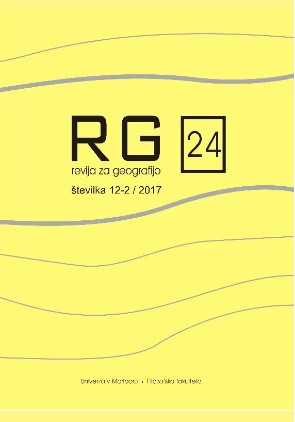Geographical reflections of mine pollution in Bosnia and Herzegovina and Croatia
DOI:
https://doi.org/10.18690/rg.12.2.3994Keywords:
mines, minefields, rural communities of Croatia and Bosnia and HerzegovinaAbstract
Numerous landmine fields cause an immense problem for the development of economy in rural areas of the Republic of Croatia and Bosnia and Herzegovina. Even twenty years after the Homeland War in Croatia, i.e. the same period after signing the Dayton Accord and war cessation in Bosnia and Herzegovina, huge areas are still contaminated with landmines. In Croatia are approximately 1.69 % of contaminated territory agricultural areas in the east part of country, forests and forestry land, i.e. pastures in highlands and the Mediterranean areas are most endangered. Bosnia and Herzegovina is one of the most landmine contaminated countries in the world. Severe landmine contamination in Bosnia and Herzegovina has been detected on pasture and forestry land, in the vicinity of the former war zone, in the central part of the country. Out of the total number of 1,366 landmine contaminated settlements in the Bosnia and Herzegovina territory, some 1,169 are rural communities.
Downloads
References
A guide to socio-economic approaches to Mine action planning and management, 2004, Geneva.
Bajić M, Krtalić A., Matić Č., Vuletić D.:Minefield indicators and analytical mine contamination assessment in scientific projects and practice. International symposium “Humanitarian demining 2009”, 7-11, 2009.
Caswell P.: Insight into GIS Usage in Dangerous Area Survey, The Journal of ERW and mine action, Issue 13.3, 2009.
Elliot G. And Harris G.: A cost-benefit analysis of landmine clearance in Mozambique. Development Southern Africa, 2001.
Gibson J., Barns S., Cameron M., Lim S., Scrimgeour F., Tressler J.: The value of statistical life and the economics of landmine clearance in developing countries. World development, 35 (3), 512-531, 2007. https://doi.org/10.1016/j.worlddev.2006.05.003
Harpviken K. B., Millard A. S., Kjellman K. E., Skara B. A.: Measures for mines: approaches to impact assessment in humanitarian mine action. Third World Quaterly, 24 (5), 889-908, 2003. https://doi.org/10.1080/0143659032000132911
Harpviken K. B. and Isaksen J.: Reclaiming the fields of war: mainstreaming mine action in development, UNDP, 2004.
Harris G.: The economics of landmine clearance: case study of Cambodia, Journal of international development, 12 (2), 219-225, 2000.
Harris G.: The economics of landmine clearance in Afganistan, Disasters, 26 (1), 49-54,, 2001. https://doi.org/10.1111/1467-7717.00190
Henig D.: Iron in the soil: living with military waste in Bosnia and Herzegovina. Anthropology today, 28 (1), 21-23, 2012. https://doi.org/10.1111/j.1467-8322.2012.00851.x
Hudson N.: Field measurement of soil erosion and runoff, Issue 68, Food and agriculture organization of the United Nations, 121-126, 1993.
Izvješće o provedbi plana humanitarnog razminiranja, Sisak, 2009.
Jebens M.: Analyzing Functionality of Landmines and Clearance Depth as a Tool to Define Clearance Methodology, The jornal of ERW an mine action, issue 17,2, 2013.
Kinra S. and Black M. E.: Landmine related injuries in children of Bosnia and Herzegovina 1991-2000: comparisons with adults, Journal of epidemiology and community health, 57 (4), 264-265, 2003. https://doi.org/10.1136/jech.57.4.264
Krtalić A. and Matić Č.: Statistical processing of minefield records, International Symposium “Humanitarian demining 2010”, 78-80, 2010. https://doi.org/10.3390/electronics13050814
Krug E. G. and Gjini A.: Number of landmine victims in Kosovo is high, British medical journal, 450, 1999. https://doi.org/10.1136/bmj.319.7207.450
Landmine Monitor, International Campaign to Ban Landmines – Cluster Munition Coalition (ICBL-CMC), 2016
McAdam J.:The impact of the Falklands war (1982) on the Peatland ecosystem of the islands, War and peat conference procedings, Sheffield, 159-176, 2013.
McGrath R.: Landmines and unexploded ordnance: a resource book, 288, 2000.
Mitasova H. and Mitas L.: Terrain analysis and erosion modeling, GMS Laboratory, University of Illinois at Urbana-Champaign, 1998.
Mrkobrad M.: Šume pod minama, Hrvatske šume, 148, 3-8, 2009.
Nacionalni program protuminskog djelovanja Republike Hrvatske, 2010.
Operativni plan protuminskih akcija centra za uklanjanje mina u Bosni i Hercegovini za 2010., Sarajevo, 2009.
Overview of acitivities of donors 2009 – 2010, Document drafted upon financial and technical assistance of DFID Bosnia and Herzegovina, Sarajevo, 2010.
Plan humanitarnog razminiranja za 2010. godinu, Zagreb, 2009.
Report on antimine actions in Bosnia and Herzegovina for 2014, Sarajevo, 2014.
Report on implementation plan of humanitarian demining and funding for 2013, Zagreb-Sisak, 2013.
Šiljković Ž., Čuka A., Pejdo A.: Rural area transformation: from cropland to minefields – Zemunik Donji Municipality (Croatia) case study, Društvena istraživanja, 2011. https://doi.org/10.5559/di.20.4.12
Valjarević A., Srećković-Batoćanin D.,Živković D., Perić M.: GIS analysis of dissipation time of landscape in Devil’s city (Serbia), Acta Montanistica Slovaca, Volume 20, number 2, 148-155, 2015.
UNEP: Guidelines for Sediment Control Practices in the Insular Caribbean. CEP Technical Report No. 32 UNEP Caribbean Environment Programme, Kingston, Jamaica, 1994.
Downloads
Published
Issue
Section
License
Copyright (c) 2017 Snježana Musa, Željka Šiljković, Dario Šakić

This work is licensed under a Creative Commons Attribution 4.0 International License.
